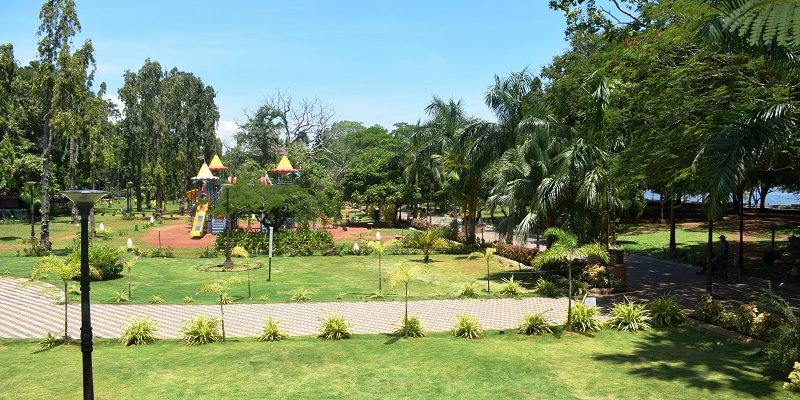FEATURE: A Live Debate – Could Indian Cities Boost Resilience by Embracing Native Trees?

Pratibha Caleb and Rithika Fernandes of ICLEI South Asia describe the range of tree species in India’s cities, and the live debate over whether native or introduced species contribute to greater urban resilience in the face of climate change impacts.
The frequency of extreme events such as droughts, floods, cyclones and other disasters are on the rise globally and will continue to have a significant impact on urban regions, both economically and socially. India has already seen two major cyclones in 2020 – Nisarga and Amphan – which have caused catastrophic damage in the areas where they made landfall, especially in the metropolitan cities of Mumbai and Kolkata, respectively. In Kolkata, about 5,000 trees were uprooted, which also brought down electricity and telephone lines and flattened numerous houses.
Cities in disaster-prone states such as Chennai, Kolkata, Visakhapatnam and Mumbai are often subject to strong winds, heavy rains and cyclonic weather, which lead to infrastructural damage and loss of lives. The most commonly affected trees are large exotic varieties such as the Gulmohar (Delonix regia), the copperpod (Peltophorum pterocarpum) and the rain tree (Albizia saman), which, because of their shallow roots system, cannot withstand the force of strong winds and fall over, damaging buildings and vehicles.
Functionality vs. aesthetics
Within Indian cities, urban green spaces (one component of urban biodiversity) receive a major chunk of the attention from urban planners and local bodies. Due to the indiscriminate concretisation of pavements in Indian cities, the Ministry of Housing and Urban Development, launched the Urban Greening Guidelines, 2014, which suggest steps for protection and maintenance of trees in urban areas. While the document does name a few tree species that are suitable to plant in certain climatic conditions or soils, it lacks the scientific rigour that is required to make such decisions. Further, the document fails to give guidance on the specific authorities that need to take up the task of assessing the type of trees that can be planted in a particular urban landscape, followed by activities related to protection, maintenance and management of trees.
Some studies have shown that Indian urban ecosystems are shaped by history, cultural preferences, and planning and management for certain types of landscaping and biodiversity. The Mughal rulers, for example, preferred fruit and shade-bearing tree species (such as mango, Java plum, fig and tamarind) and lined city avenues with these. The British, on the other hand, appeared to prefer trees such as the neem or Indian lilac, Java plum and Arjun, which they felt would bring out the aesthetics of monuments, especially within Delhi. They also considered functionality, picking species with large canopies for shade, perfume and for improving air quality. Unfortunately, the British were also responsible for introducing a number of exotic species such as Prosopis juliflora and Australian wattles (Acacia sp.), which have now become invasive within Indian ecosystems, out-competing native species for space and nutrients.
Indian planners of today seem to lean more towards aesthetics and easy maintenance, rather than functionality, preferring fast-growing, evergreen and largely ornamental species. Major Indian city avenues are lined with trees such as the Gulmohar, the copperpod, the rain tree, the African Tulip (Spathodea campanulata), and the Ashoka tree (Polyalthia longifolia), besides various exotic palms. None of these species are native to India, but have now established themselves firmly within our cities.
Native vs. introduced – the debate
A major feature of the flora within cities is the greater prevalence of non-native or introduced species in the species composition. The main difference between a native species and an introduced one is that native species are present within an ecosystem as a result of natural processes, not human action. Non-native species often cause problems within a landscape when they become invasive. The Convention on Biological Diversity recognises the threat caused by invasive species in Aichi biodiversity target 9, which states, “By 2020, invasive alien species and pathways are identified and prioritised, priority species are controlled or eradicated, and measures are in place to manage pathways to prevent their introduction and establishment.”
Introduced species are popular within city gardens and other city landscapes for their aesthetic properties such as foliage, canopy structure and showiness of flowers. They also have culinary or cultural attributes that seem attractive to a number of people. However, there is currently a lot of debate regarding their functional benefits.
Native species in comparison appear better equipped to withstand these disasters. Introduced species are also considered to negatively impact faunal abundance and species richness. Generally, native fauna prefer native flora as they have co-evolved over a long period of time to develop associations, with native plant species providing greater supporting ecosystem services (such as habitat and nutrient cycling).
However, there is a body of literature that favours non-native species, stating that these species tend to be hardier in spaces modified by urbanisation and that they, ironically, might be better adapted to respond to climate change.
Policy and institutional landscape
While the management of urban green spaces falls under the general purview of urban local bodies in India, there are statal, parastatal and district authorities who play an important role in urban greening.
Within the urban local body itself, there are variations across the board as to which department manages greening activities. In some cases, it is the Garden Department, as in Ichalkaranji and Nagpur. In other cases, it is the Pollution Control Department, as in Thane, the Town and Country Planning Department in Kochi, or the Urban Biodiversity Department in Hyderabad.
Metropolitan Development Authorities, State Departments of Environment and Forests, Horticulture and Agriculture Departments, and the National Highway Authority of India are involved in greening activities, tree plantation, and creation of parks/gardens and their maintenance. Additionally, in many cities, the electricity boards, which are state bodies, are also involved in the maintenance of urban greenery, especially pruning and canopy maintenance.
It is clear from the above-mentioned examples that the management of urban green spaces in India is not by a clearly defined local authority and varies from city to city. Vertical and horizontal cooperation and coordination, which is generally weak, is critically important for managing urban greenery.
Conclusion
Overall, while Indian cities embrace greening initiatives as a key strategy for improving urban resilience and disaster risk management, the frequent uprooting of these trees and the damage it causes, seems to defeat the purpose.
Urban greening in India lacks focus, coordination and priority in planning and implementation, both at the national and the city level.
Moving forward, urban local bodies need to develop more robust methodologies and plans to ensure that the selection and management of tree species is based on the type and function of the urban landscape in question.
Further reading
Strategic Plan for Biodiversity 2011-2020, including Aichi Biodiversity Targets. Retrieved from https://www.cbd.int/sp/ on 19 July 2020.
Secretariat of the Convention on Biological Diversity (2012). Cities and Biodiversity Outlook. Montreal, 64 pages.
Wilby, R. L. and G. L. W. Perry (2006) Climate change, biodiversity and the urban environment: A critical review based on London, UK. Progress in Physical Geography 30(1): 73-98.
Imam, A., and U. K. Banerjee. 2016. Urbanisation and greening of Indian cities: problems, practices, and policies. Ambio 45:442– 57
Chaudhry, P and Tewari, V.P. Role of public parks/gardens in attracting domestic tourists: An example from City Beautiful of India, TOURISMOS, 2010, 5: 101-109
Chaudhry, p., Bagra, K., and Singh, B. (2011). Urban Greenery Status of Some Indian Cities: A Short Communication. International Journal of Environmental Science and Development, Vol. 2, No. 2.
Garland, L. (2020). Native Versus Non-native which plants are better for biodiversity? Retrieved from https://www.thenatureofcities.com/2020/05/18/native-versus-non-native-which-plants-are-best-for-biodiversity/ on 29 July 2020.
Grahn, P and Stigsdotter U, A. Landscape planning and stress, Urban Forestry and Urban Greening, 2003, 2: 001-018.
Jim, C, Y and Chen, W, Y. Recreation-amenity use and contingent valuation of urban green spaces in Guangzhou, China. Landscape and Urban Planning, 2006, 75: 81-96.
Luttik, J. The value of trees, water and open space as reflected by house prices in the Netherlands, Landscape and Urban Planning, 2000, 48: 161-167.
Nagendra, H., and Gopal, D. (2011). Tree diversity, distribution, history and change in urban parks. Urban Ecosystems, 14, 211–223.
Nagendra H., Sudhira H.S., Katti M., Schewenius M. (2013) Sub-regional Assessment of India: Effects of Urbanization on Land Use, Biodiversity and Ecosystem Services. In: Elmqvist T. et al. (eds) Urbanization, Biodiversity and Ecosystem Services: Challenges and Opportunities. Springer, Dordrecht.



